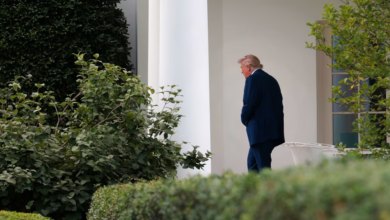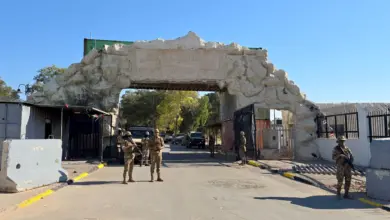
CAIRO (AP) — Libya has been plunged into chaos again, with forces loyal to a polarizing military commander marching on the capital and trading fire with militias aligned with a weak U.N.-backed government.
The battle for Tripoli could ignite civil war on the scale of the 2011 uprising that toppled and killed longtime dictator Moammar Gadhafi. That conflict left behind a patchwork of local, tribal and Islamist militias governing various fiefdoms, often through extortion and brute force. It also transformed Libya into a haven for extremists and a major conduit for migrants making perilous journeys to Europe.
Field Marshal Khalifa Hifter, who has spent the last few years battling Islamic militants in eastern Libya, presents himself as a strong hand that can unify the country and rid it of extremists. But his opponents view him as another would-be strongman in the mold of Gadhafi.
HOW DID LIBYA GET HERE?
Inspired by the Arab Spring uprisings sweeping the region, Libyans rose up in February 2011 against Gadhafi, who responded with a fierce military crackdown. As the uprising quickly escalated into a civil war, Gadhafi massed tanks outside the eastern city of Benghazi and threatened to massacre the protesters street by street.
NATO responded with a bombing campaign against Gadhafi’s forces, and eventually provided close air support to a loose alliance of rebel militias, helping them to drive him from power. The rebels captured Gadhafi in his home city of Sirte in October 2011 and killed him, later releasing video footage of him being beaten and humiliated.
Libya held free elections the following year, but the government was powerless to control the vast array of militias, and the democratic transition stalled. Fighting erupted in Tripoli in the summer of 2014, leaving the international airport largely destroyed and resulting in separate governments in the capital and in eastern Libya, each backed by various armed groups.
In 2015, the U.N. backed the formation of a transitional government in Tripoli, in the west, under the leadership of technocrat Fayez Sarraj. A separate government, based in the east and allied with Hifter, has rejected its authority.
___
WHO IS HIFTER?
Hifter helped Gadhafi seize power in a 1969 coup against the monarchy and rose through the ranks of the military, eventually commanding Libyan forces in the 1973 Arab-Israeli war. But his reputation was left in tatters by Libya’s disastrous defeat in the war with Chad in the 1980s, in which he was among thousands captured.
As the war wound down, he defected and joined the armed opposition to Gadhafi, orchestrating a number of failed coup attempts. He eventually relocated to the Washington, D.C. area, where he lived in exile for 20 years, leading to widespread speculation that he worked with the CIA.
He returned to Libya in 2011 and commanded forces during the uprising against Gadhafi. But he soured on the revolution during the chaos following the dictator’s death, and soon organized a campaign against the various Islamic militant groups that took root in eastern Libya.
In recent years he has fought a series of battles there, leaving a swath of destruction but eventually retaking most of eastern Libya and its vital oil facilities. Over the last few months he has quietly expanded his influence across the south, winning over local tribes and factions.
He has cast his opponents as Islamic extremists and modeled himself on President Abdel-Fattah el-Sissi in neighboring Egypt, who led the military overthrow of an elected but divisive Islamist president in 2013 and has since presided over an unprecedented crackdown on dissent.
Hifter is supported by Egypt, as well as the United Arab Emirates, Russia and France. His supporters see him as the best hope of stabilizing the troubled country and combating extremists.
___
WHO IS HE FIGHTING?
Hifter is expected to face stiff resistance from powerful militias from the western cities of Misrata and Zawiya, two areas that saw heavy fighting during the 2011 uprising. The Zawiya militias captured 100 of Hifter’s forces on Friday, the day after he launched his offensive. The battle-hardened Misratans led the fight against an Islamic State group affiliate in 2016, eventually driving it from its last stronghold in Sirte with U.S. air support.
The Tripoli factions present themselves as heirs to the 2011 revolution, but they are widely blamed for derailing the political transition through kidnappings — including of a transitional prime minister — extortion and violence.
They have received support from Turkey and Qatar as part of the regional rivalry between those two countries and Egypt and the United Arab Emirates. European countries have provided aid to local armed groups to stem the flow of migrants, battle extremists and protect oil supplies.
The U.N.-backed government has sought support from the militias as it has struggled to gain a foothold in the capital, while the militias have clashed with each other, most recently in September.
The U.N. Security Council has meanwhile called on Hifter to halt his advance and for all sides to de-escalate the situation. U.N. envoy Ghassan Salame says he still hopes to convene a national conference later this month to plan for elections.
FILE – In this Oct. 7, 2011, file, photo, a Libyan revolutionary fighter runs for cover while attacking pro-Gadhafi forces in Sirte, Libya. Libya has been plunged into chaos again, with forces loyal to a polarizing military commander marching on the capital and trading fire with militias aligned with a weak U.N.-backed government.(AP Photo/Manu Brabo, File)




